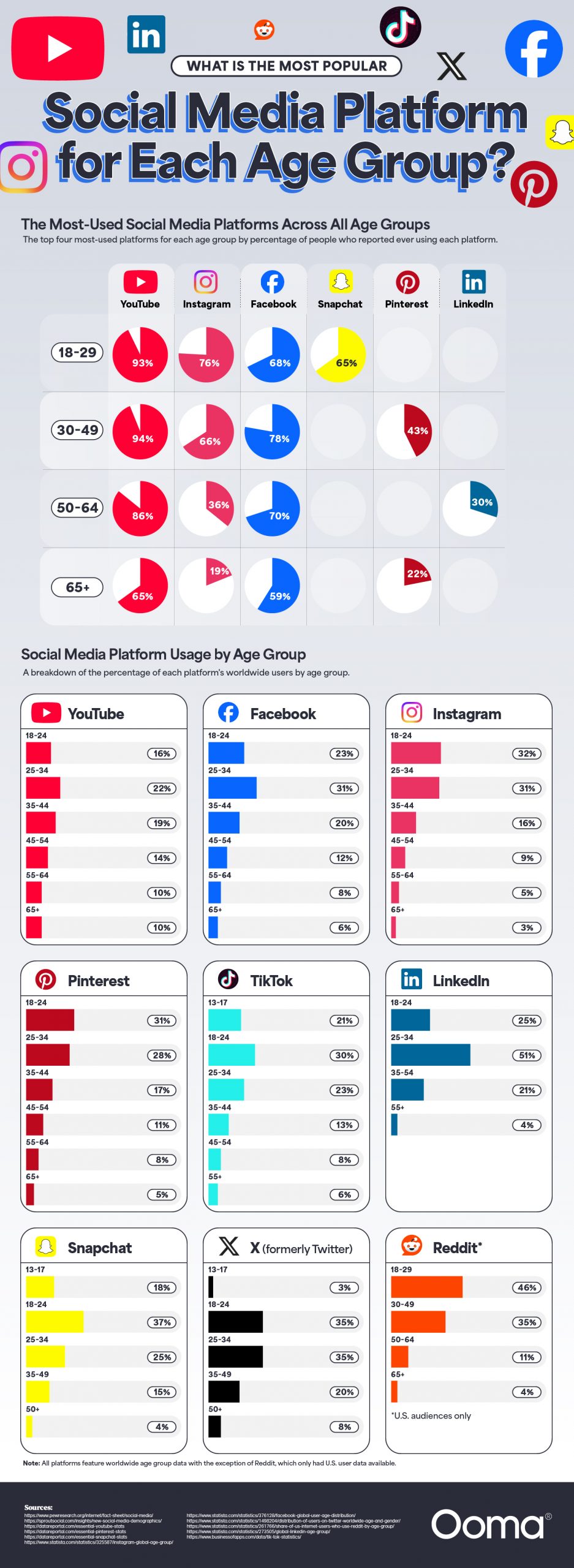Social media platforms function as virtual town squares, connecting billions of people every day. However, these online spaces aren’t demographically uniform—each platform appeals to different age groups at varying rates.
The demographic landscape is constantly evolving, with younger users actively exploring new platforms while older generations are increasingly embracing digital connectivity. These trends not only shape the development of platforms but also influence the way information is spread between generations. It is not uncommon to see young generations migrating from what was their preferred platform as older generations begin to adopt them. Recognizing these patterns provides valuable insights for marketers, researchers and everyday users alike.
To identify which age groups are most engaged with each social platform, the research team at Ooma analyzed data from the Pew Research Center’s Social Media Fact Sheet along with other reputable sources on social media demographics by age in the United States and worldwide.

The most-used social media platforms across all age groups in the United States
| Age Group | YouTube | Snapchat | TikTok | ||||
|---|---|---|---|---|---|---|---|
| 18–29 | 93% | 76% | 68% | 65% | 43% | 40% | 59% |
| 30–49 | 94% | 66% | 78% | 32% | 43% | 41% | 40% |
| 50–64 | 86% | 36% | 70% | 14% | 33% | 30% | 26% |
| 65+ | 65% | 19% | 59% | 4% | 22% | 10% | 10% |
Source: Pew Research Center
It’s no surprise that YouTube is the most widely used social platform across all age groups.
As the world’s second-largest search engine after Google, it naturally attracts more users than other platforms. Additionally, since Google owns YouTube, YouTube video results are featured on Google Search’s results pages, giving YouTube a significant advantage over other video and social platforms.
An interesting finding from social media statistics is that 68 percent of individuals aged 18 to 29 and 78 percent of those aged 30 to 49 use Facebook. With the rise of newer platforms like Snapchat and TikTok, Facebook is often perceived as being favored by older generations. However, the data shows that this is not the case; Facebook remains one of the most widely used social platforms regardless of age. With 3.07 billion users worldwide, it’s clear that its audience extends far beyond just baby boomers and Generation X.
A less surprising statistic is that LinkedIn is most popular among people ages 50 to 64. This could be attributed to the platform’s focus on business networking rather than personal social interactions. Regardless of the reason, LinkedIn didn’t show up as one of the four most-used platforms among any other age range, although 51 percent of worldwide users between 25 and 34 years old responded that they use LinkedIn at least occasionally.
Which age group uses social media the most in the United States?
According to a survey of U.S. adults conducted by the Pew Research Center, the 18-to-29 age group is the most prominent on social media, most actively using YouTube (93 percent), Instagram (76 percent), Facebook (68 percent), Snapchat (65 percent) and TikTok (59 percent). In contrast, the 65-and-older age group demonstrates much less (though still significant) engagement, favoring YouTube (65 percent), Facebook (59 percent), Pinterest (22 percent) and Instagram (19 percent).
Which age groups engage most with each social media platform worldwide?
Interestingly, the age group that uses YouTube the most worldwide is the 25-to-34 range, accounting for 22 percent of the platform’s users. This popularity may stem from YouTube’s diverse offerings, including entertainment, education and revenue generation. Since this age group has the biggest percentage of users, it makes sense that many YouTube influencers belong to it, using the platform to build substantial audiences across demographics.
Another noteworthy observation is that the majority of users on X (formerly Twitter) are concentrated in two age groups, 18 to 24 and 25 to 34, each making up 35 percent of the user base. The next largest group is the 35-to-49 age range, at 20 percent. However, these figures are subject to change, as the platform has experienced a continuous decline in user numbers. As of December 2024, X had lost 2.7 million active users in just two months, and this trend has persisted into 2025. Despite this, the platform still boasts approximately 611 million monthly active users.
Platforms are like living organisms. As user preferences change, new social media platforms emerge and audiences age, it’s reasonable to assume these statistics will change, too. One thing is for sure: social media is here to stay.
How social media has transformed our world
Social media has fundamentally reshaped modern culture, evolving from simple digital tools into essential parts of our collective identity. What started as basic platforms for connection has developed into powerful forces impacting politics, commerce, entertainment and personal relationships.
Today, cultural moments are created, amplified and immortalized through hashtags and viral content, while social movements gain momentum through digital solidarity and unity. Language itself has adapted, incorporating platform-specific slang and emoji communication into everyday conversation.
For many, particularly younger people who have never experienced a world without these platforms, social media does not merely reflect culture—it actively shapes it. This blurs the lines between online and offline existence, making the distinction increasingly vague.
Our shared experiences, ranging from global events to personal milestones, are now instinctively filtered through the lens of social shareability. This shift has permanently changed how we perceive, document and engage with culture.
Enhance your communication with Ooma
In today’s digital age, having a modern and reliable communication system is essential, no matter which online platforms you or your customers prefer. This is where Ooma’s affordable home and business services come in. Ooma has a VoIP home phone service with crystal-clear voice quality. Ooma Office offers businesses a wide-range of communication services from phone systems with more than 100 features, to primary or backup wireless internet.
Social media platform usage by age group
YouTube
| Age Range | Percentage |
|---|---|
| 18–24 | 16% |
| 25–34 | 22% |
| 35–44 | 19% |
| 45–54 | 14% |
| 55–64 | 10% |
| 65+ | 10% |
| Age Range | Percentage |
|---|---|
| 18–24 | 23% |
| 25–34 | 31% |
| 35–44 | 20% |
| 45–54 | 12% |
| 55–64 | 8% |
| 65+ | 6% |
| Age Range | Percentage |
|---|---|
| 18–24 | 32% |
| 25–34 | 31% |
| 35–44 | 16% |
| 45–54 | 9% |
| 55–64 | 5% |
| 65+ | 3% |
| Age Range | Percentage |
|---|---|
| 18–24 | 31% |
| 25–34 | 28% |
| 35–44 | 17% |
| 45–54 | 11% |
| 55–64 | 8% |
| 65+ | 5% |
TikTok
| Age Range | Percentage |
|---|---|
| 13–17 | 21% |
| 18–24 | 30% |
| 25–34 | 23% |
| 35–44 | 13% |
| 45–54 | 8% |
| 55+ | 6% |
| Age Range | Percentage |
|---|---|
| 18–24 | 25% |
| 25–34 | 51% |
| 35–54 | 21% |
| 55+ | 4% |
Snapchat
| Age Range | Percentage |
|---|---|
| 13–17 | 18% |
| 18–24 | 37% |
| 25–34 | 25% |
| 35–49 | 15% |
| 50+ | 4% |
X (formerly Twitter)
| Age Range | Percentage |
|---|---|
| 13–17 | 3% |
| 18–24 | 35% |
| 25–34 | 35% |
| 35–49 | 20% |
| 50+ | 8% |
Reddit*
| Age Range | Percentage |
|---|---|
| 18–29 | 46% |
| 30–49 | 35% |
| 50–64 | 11% |
| 65+ | 4% |
*U.S. audiences only
Sources:
- https://www.pewresearch.org/internet/fact-sheet/social-media
- https://sproutsocial.com/insights/new-social-media-demographics/
- https://datareportal.com/essential-youtube-stats
- https://datareportal.com/essential-pinterest-stats
- https://datareportal.com/essential-snapchat-stats
- https://www.statista.com/statistics/325587/instagram-global-age-group/
- https://www.statista.com/statistics/376128/facebook-global-user-age-distribution/
- https://www.statista.com/statistics/1498204/distribution-of-users-on-twitter-worldwide-age-and-gender/
- https://www.statista.com/statistics/261766/share-of-us-internet-users-who-use-reddit-by-age-group/
- https://www.statista.com/statistics/273505/global-linkedin-age-group/
- https://www.businessofapps.com/data/tik-tok-statistics/




